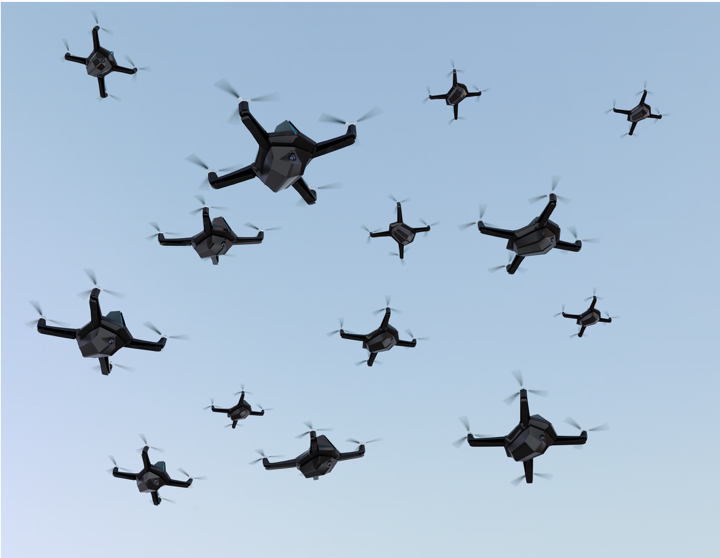Distributed autonomous sensing systems
Contact: Raj Thilak Rajan

The Distributed Autonomous Systems theme centers on the fundamental signal processing challenges of multi-agent sensing systems. The current research focus is on distributed/decentralized processing, probabilistic machine learning, federated learning, resource allocation, autonomous inference through sensor fusion, and PNT (Position, Navigation and Timing). One of the underlying challenges is to develop algorithms for resource constrained sensor systems and systems deployed in inaccessible/intermittentily accesible locations. We work closely with various universities (e.g, TU/e, Radboud), research institutes (e.g., TNO, SRON, NLR) and industries (e.g., VSL, KPN, NXP), in the Netherlands and internationally.
Techniques
- Estimation and Detection theory
- Convex and Non-convex optimization, Mixed integer optimization
- Statistical signal processing, performance analysis, and bounds
- Distributed signal processing and Distributed systems
- Parametric/Non-parametric models for complex dynamical systems
- Dynamics and Kinematics of multi-agent systems
- Probabilistic machine learning, Sensor fusion
- Information theory and Sparse representations
- Affine transformations, SE(d) and SO(d) groups
Applications
- Wireless sensor networks
- Cooperative and non-cooperative localization and tracking of mobile agents
- Data and clock synchronization, multi-sensor calibration
- Autonomous navigation, Environment perception, Path planning and Detect and Avoid
- Multi-agent systems e.g., aircrafts, rovers, satellite arrays and drone swarms
- Learning underlying manifolds in unknown environements using multi-agent systems
- Formation control of multi-agent systems
Research Themes
- Signal processing for Distributed inference: Sensor systems consist of numerous nodes with only local communication capabilities. Challenges include localization of the nodes, clock synchronization, low-power communication protocols, and distributed estimation/detection algorithms (e.g., consensus, ADMM, PDMM), where local estimates are combined to form global parameter estimates.
- Signal processing for Autonomous inference: A single system consisting of multi-modal sensors (e.g., IMU, Camera, LIDAR, Radar) aims to autonomous perform desired tasks with minimal control from other actors/agents/humans e.g., environmental perception, path planning, detect and avoid, and self-calibration. How can the diverse streams of data from various sensors (e.g., continuous, discrete, intermittently available, block datasets) be combined in a prudent way for optimal statistical inference?
- Signal processing for multi-agent mobile systems: Consider a network of mobile agents (e.g., automotive, satellites, rovers, drones), which cooperatively perform a given task e.g., platooning, collaborative path planning and formation flying. How can we exploit the underlying physics, and optimally combine information of kinematics and dynamics of these multi-agent systems to perform these tasks? These tasks involve a combination of estimation, detection, information processing and control theory.
Projects under this theme
AQUAFIND
Distributed localisation and formation control of drones
ShapeFuture
On-board robust cognition and decision making for highly automated vehicles.
Reliable POwerDown for Industrial Drives
The pioneering EU research project R-PODID started on the 1st of September 2023. This KDT JU co-funded project aims to develop an automated, cloudless, short-term fault-prediction for electric drives, power modules, and power devices, that can be integrated into power converters.
Moonshot
Science, technology and Social solutions for Lunar missions
Signal processing for environment-aware radar
In future, cars will exploit multiple radars towards autonomous driving. Before this becomes a reality, several challenges will have to be solved.
Delft Sensor AI Lab
Bringing AI to sensor networks
Cooperative Relative Navigation of Multi-agent Systems
Develop algorithms for multi-target position, time and orientation tracking in a mobile network of multi-agent systems
History
Automotive Intelligence for Connected Shared Mobility
Architectures for embedded intelligence and functional virtualization for connected and shared mobility using trustworthy AI
Distributed Artificial Intelligent Systems
Running existing algorithms on vastly distributed edge devices
Airborne data collection on resilient system architectures
Develop algorithms to realize efficient, robust, cost-effective perception and control for autonomous navigation of drones
PIPP OLFAR: Breakthrough technologies for Interferometry in Space
Combine multiple satellites into one single scientific instrument: a radio telescope in space
Low-frequency distributed radio telescope in space
Below 15 MHz, the ionosphere blocks EM signals from the sky. Therefore, can we design a radio telescope in space, using a swarm of inexpensive nano-satellites? Accurate localization and clock recovery is important.
MSc students
- Josephine King
- Hongyu Zhou
- Alexander James Becoy
Alumni
- Yogesh Prasanna Kumar Rao (2025)
- Zhixuan Ge (2025)
- Nikos Fotopoulos (2025)
- Yi Dai (2025)
- Shaan Hossain (2025)
- Ibrahim Hassan (2024)
- Srikar Chaganti (2024)
- Zeineh Bou Cher (2024)
- Anitha Koshy (2024)
- Luke Rijk de Waal (2024)
- Xi Chen (2024)
- Ban Hanyuan (2023)
- Haobo Wang (2023)
- Jingwen Dun (2023)
- Lan Jia (2023)
- Vishakha Marathe (2023)
- Xuchang Zhang (2023)
- Thomas Manteaux (2023)
- Wenrui Yu (2023)
- Jonathan Dijkstra (2023)
- Siddhy Ganesh Shetty (2022)
- Xuzhou Yang (2022)
- Zhonggang Li (2022)
- Peiyuan Zhai (2022)
- Mosab Diab (2022)
- Rui Tang (2022)
- Calum Turner (2021)
- Bichi Zhang (2021)
- Felix Abel (2021)
- Elke Salzmann (2021)
- Martijn van der Marel (2021)
- Yikai Zeng (2020)